NURSING: Case Study of Melanie Johnson, Renal Failure
VerifiedAdded on 2022/10/08
|10
|2846
|16
Case Study
AI Summary
This case study focuses on a 55-year-old woman, Melanie Johnson, diagnosed with chronic renal failure. The assignment delves into the basics of renal anatomy and physiology, the pathophysiology of chronic renal failure, and explores treatment options like haemodialysis and kidney transplantation. It highlights the differences between acute and chronic renal failure, and discusses renal replacement therapy. The case study analyzes Melanie's medications, valsartan and Eprex, including their indications, side effects, and nursing interventions. It also examines Melanie's blood test results and provides patient education using the teach-back method, focusing on managing fluid intake and addressing anemia-related fatigue. The assignment integrates the patient's history, symptoms, and treatment plan to provide a comprehensive overview of chronic renal failure management.
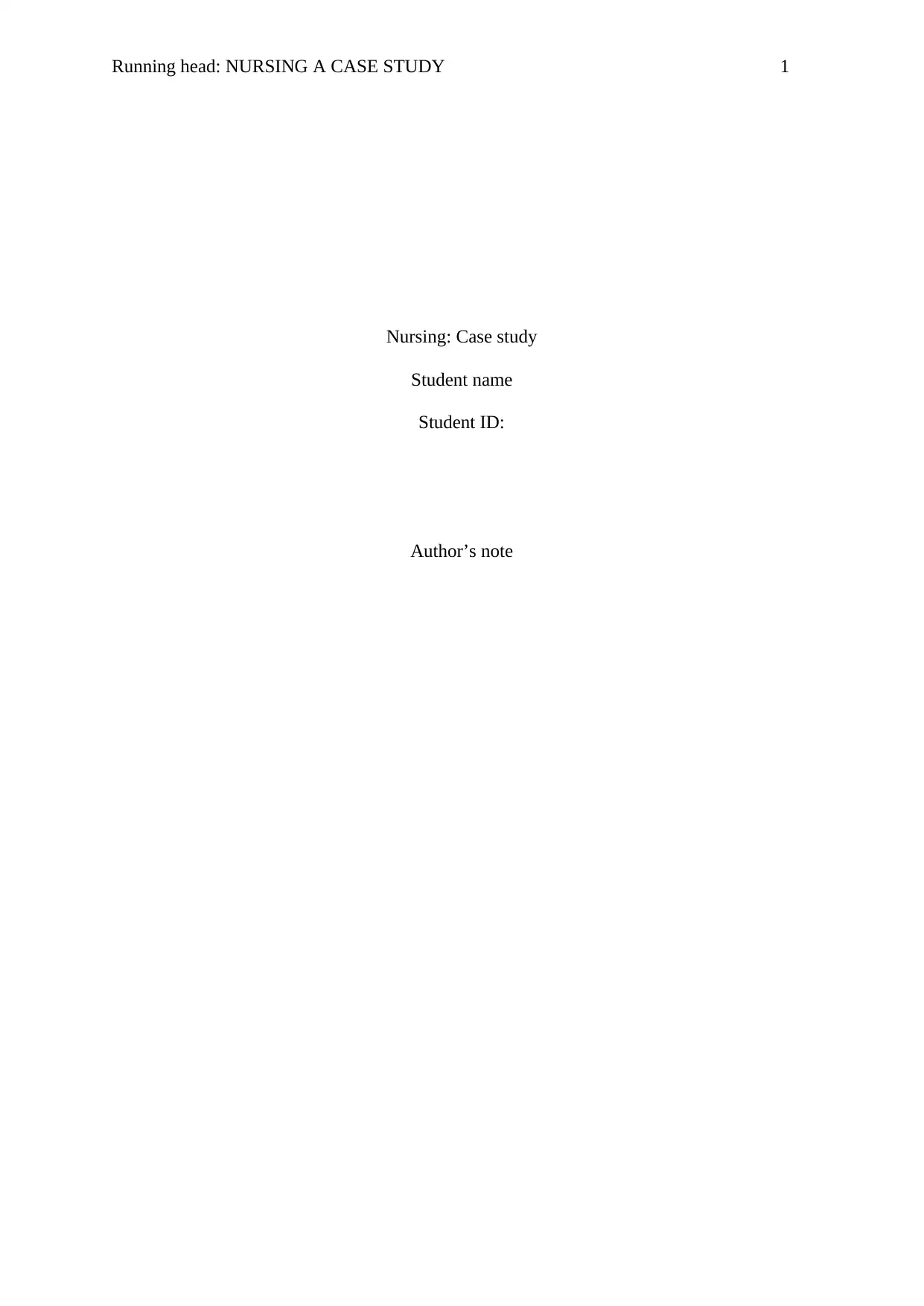
Running head: NURSING A CASE STUDY 1
Nursing: Case study
Student name
Student ID:
Author’s note
Nursing: Case study
Student name
Student ID:
Author’s note
Paraphrase This Document
Need a fresh take? Get an instant paraphrase of this document with our AI Paraphraser
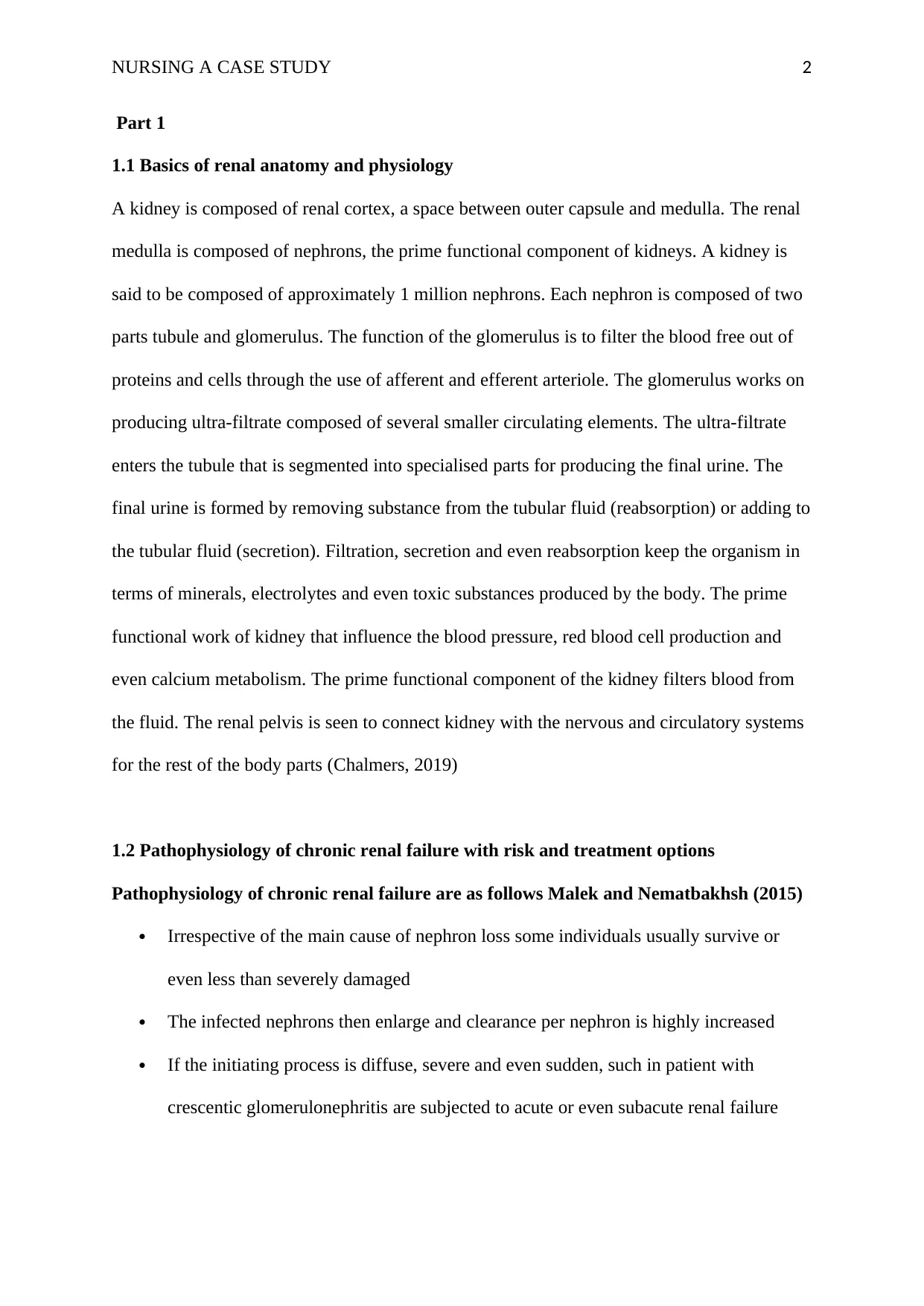
NURSING A CASE STUDY 2
Part 1
1.1 Basics of renal anatomy and physiology
A kidney is composed of renal cortex, a space between outer capsule and medulla. The renal
medulla is composed of nephrons, the prime functional component of kidneys. A kidney is
said to be composed of approximately 1 million nephrons. Each nephron is composed of two
parts tubule and glomerulus. The function of the glomerulus is to filter the blood free out of
proteins and cells through the use of afferent and efferent arteriole. The glomerulus works on
producing ultra-filtrate composed of several smaller circulating elements. The ultra-filtrate
enters the tubule that is segmented into specialised parts for producing the final urine. The
final urine is formed by removing substance from the tubular fluid (reabsorption) or adding to
the tubular fluid (secretion). Filtration, secretion and even reabsorption keep the organism in
terms of minerals, electrolytes and even toxic substances produced by the body. The prime
functional work of kidney that influence the blood pressure, red blood cell production and
even calcium metabolism. The prime functional component of the kidney filters blood from
the fluid. The renal pelvis is seen to connect kidney with the nervous and circulatory systems
for the rest of the body parts (Chalmers, 2019)
1.2 Pathophysiology of chronic renal failure with risk and treatment options
Pathophysiology of chronic renal failure are as follows Malek and Nematbakhsh (2015)
Irrespective of the main cause of nephron loss some individuals usually survive or
even less than severely damaged
The infected nephrons then enlarge and clearance per nephron is highly increased
If the initiating process is diffuse, severe and even sudden, such in patient with
crescentic glomerulonephritis are subjected to acute or even subacute renal failure
Part 1
1.1 Basics of renal anatomy and physiology
A kidney is composed of renal cortex, a space between outer capsule and medulla. The renal
medulla is composed of nephrons, the prime functional component of kidneys. A kidney is
said to be composed of approximately 1 million nephrons. Each nephron is composed of two
parts tubule and glomerulus. The function of the glomerulus is to filter the blood free out of
proteins and cells through the use of afferent and efferent arteriole. The glomerulus works on
producing ultra-filtrate composed of several smaller circulating elements. The ultra-filtrate
enters the tubule that is segmented into specialised parts for producing the final urine. The
final urine is formed by removing substance from the tubular fluid (reabsorption) or adding to
the tubular fluid (secretion). Filtration, secretion and even reabsorption keep the organism in
terms of minerals, electrolytes and even toxic substances produced by the body. The prime
functional work of kidney that influence the blood pressure, red blood cell production and
even calcium metabolism. The prime functional component of the kidney filters blood from
the fluid. The renal pelvis is seen to connect kidney with the nervous and circulatory systems
for the rest of the body parts (Chalmers, 2019)
1.2 Pathophysiology of chronic renal failure with risk and treatment options
Pathophysiology of chronic renal failure are as follows Malek and Nematbakhsh (2015)
Irrespective of the main cause of nephron loss some individuals usually survive or
even less than severely damaged
The infected nephrons then enlarge and clearance per nephron is highly increased
If the initiating process is diffuse, severe and even sudden, such in patient with
crescentic glomerulonephritis are subjected to acute or even subacute renal failure

NURSING A CASE STUDY 3
In case of Melanie, the progression of disease is gradual and adaptation of nephron is
possible.
Focal glomerulosclerosis is seen to develop within the affected glomeruli and they
eventually start to lose their function.
Simultaneously, focal glomerulosclerosis can lead to development of proteinuria that
thereby causes the worsening of systematic hypertension
The process of nephron adaption can be termed as “final common path”
The adapted nephron can work on enhancing the ability of the kidney to delay the
incident of uremia. However, it should be noted that the untimely process of
adaptation can lead to death of nephrons.
Adapted nephron are not only equipped with enhanced level of glomerular filtrate
rate, but also better tubular functions in terms of proton and even potassium secretion
Pathophysiology and Clinical manifestation
The condition of Melanie is seen to degrade, a normal phenomenon for individuals suffering
from progressive renal failure. In case of Melanie and even the other cases, patients are often
seen to exhibit constancy of the internal environment of kidney until there is a loss of 75% of
renal capability. Individuals with uremic manifestation can have different complications that
can happen in other body parts. All CRF patients with those except medullary cystic kidney
disease is seen to have fixed levels of proteinuria (Bernal et al. 2015). The syndrome of
Melanie came into attention due to high levels of creatinine, 90 umol/L. The progressive
metabolic acidosis can be termed as one of the leading cause that leads to failure of the
kidneys. As pointed out by Bernal et al. (2015), a prime cause of failure to excrete excess
levels of acid is reduced renal ammonia excretion and even production.
However, it would be fair enough to state that major metabolic acidosis of renal failure is
often referred to as anion gap acidosis, the gap does not reveal until there is an increase in the
In case of Melanie, the progression of disease is gradual and adaptation of nephron is
possible.
Focal glomerulosclerosis is seen to develop within the affected glomeruli and they
eventually start to lose their function.
Simultaneously, focal glomerulosclerosis can lead to development of proteinuria that
thereby causes the worsening of systematic hypertension
The process of nephron adaption can be termed as “final common path”
The adapted nephron can work on enhancing the ability of the kidney to delay the
incident of uremia. However, it should be noted that the untimely process of
adaptation can lead to death of nephrons.
Adapted nephron are not only equipped with enhanced level of glomerular filtrate
rate, but also better tubular functions in terms of proton and even potassium secretion
Pathophysiology and Clinical manifestation
The condition of Melanie is seen to degrade, a normal phenomenon for individuals suffering
from progressive renal failure. In case of Melanie and even the other cases, patients are often
seen to exhibit constancy of the internal environment of kidney until there is a loss of 75% of
renal capability. Individuals with uremic manifestation can have different complications that
can happen in other body parts. All CRF patients with those except medullary cystic kidney
disease is seen to have fixed levels of proteinuria (Bernal et al. 2015). The syndrome of
Melanie came into attention due to high levels of creatinine, 90 umol/L. The progressive
metabolic acidosis can be termed as one of the leading cause that leads to failure of the
kidneys. As pointed out by Bernal et al. (2015), a prime cause of failure to excrete excess
levels of acid is reduced renal ammonia excretion and even production.
However, it would be fair enough to state that major metabolic acidosis of renal failure is
often referred to as anion gap acidosis, the gap does not reveal until there is an increase in the
⊘ This is a preview!⊘
Do you want full access?
Subscribe today to unlock all pages.

Trusted by 1+ million students worldwide
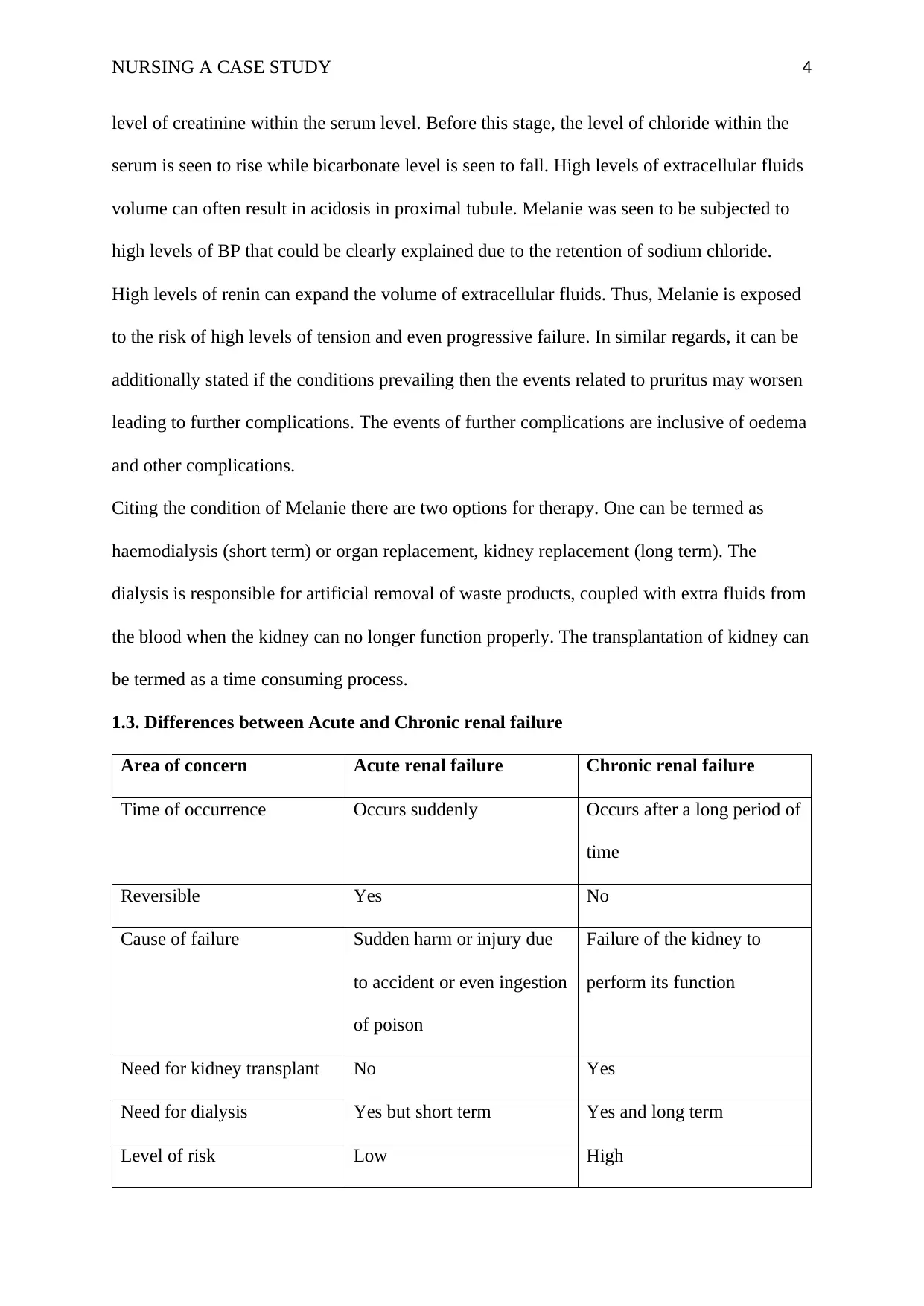
NURSING A CASE STUDY 4
level of creatinine within the serum level. Before this stage, the level of chloride within the
serum is seen to rise while bicarbonate level is seen to fall. High levels of extracellular fluids
volume can often result in acidosis in proximal tubule. Melanie was seen to be subjected to
high levels of BP that could be clearly explained due to the retention of sodium chloride.
High levels of renin can expand the volume of extracellular fluids. Thus, Melanie is exposed
to the risk of high levels of tension and even progressive failure. In similar regards, it can be
additionally stated if the conditions prevailing then the events related to pruritus may worsen
leading to further complications. The events of further complications are inclusive of oedema
and other complications.
Citing the condition of Melanie there are two options for therapy. One can be termed as
haemodialysis (short term) or organ replacement, kidney replacement (long term). The
dialysis is responsible for artificial removal of waste products, coupled with extra fluids from
the blood when the kidney can no longer function properly. The transplantation of kidney can
be termed as a time consuming process.
1.3. Differences between Acute and Chronic renal failure
Area of concern Acute renal failure Chronic renal failure
Time of occurrence Occurs suddenly Occurs after a long period of
time
Reversible Yes No
Cause of failure Sudden harm or injury due
to accident or even ingestion
of poison
Failure of the kidney to
perform its function
Need for kidney transplant No Yes
Need for dialysis Yes but short term Yes and long term
Level of risk Low High
level of creatinine within the serum level. Before this stage, the level of chloride within the
serum is seen to rise while bicarbonate level is seen to fall. High levels of extracellular fluids
volume can often result in acidosis in proximal tubule. Melanie was seen to be subjected to
high levels of BP that could be clearly explained due to the retention of sodium chloride.
High levels of renin can expand the volume of extracellular fluids. Thus, Melanie is exposed
to the risk of high levels of tension and even progressive failure. In similar regards, it can be
additionally stated if the conditions prevailing then the events related to pruritus may worsen
leading to further complications. The events of further complications are inclusive of oedema
and other complications.
Citing the condition of Melanie there are two options for therapy. One can be termed as
haemodialysis (short term) or organ replacement, kidney replacement (long term). The
dialysis is responsible for artificial removal of waste products, coupled with extra fluids from
the blood when the kidney can no longer function properly. The transplantation of kidney can
be termed as a time consuming process.
1.3. Differences between Acute and Chronic renal failure
Area of concern Acute renal failure Chronic renal failure
Time of occurrence Occurs suddenly Occurs after a long period of
time
Reversible Yes No
Cause of failure Sudden harm or injury due
to accident or even ingestion
of poison
Failure of the kidney to
perform its function
Need for kidney transplant No Yes
Need for dialysis Yes but short term Yes and long term
Level of risk Low High
Paraphrase This Document
Need a fresh take? Get an instant paraphrase of this document with our AI Paraphraser

NURSING A CASE STUDY 5
Table 1: Difference between acute and chronic renal failure
(Source: Ferenbach & Bonventre, 2016)
1.4. Discuss renal replacement therapy
Despite with the high rates of improvement in regards to renal replacement therapy, the rates
of mortality remains high. Within the demographic of adult critical care, the continuous
modes of renal replacement therapy are generally opted for, although hybrid therapies
continue to remain in trend (Nistor et al. 2014). In similar regards, it can be additionally
stated evidence based study related to renal replacement therapies suggest the continuous
modes of renal replacement therapies are often linked with reduced long term dependence on
dialysis. In similar regards, it can be easily stated there remains no benefit associated with
high intensity of renal replacement therapies as part of daily mode of care. In similar regards,
it would be fair enough to state that the course of renal replacement therapy needs to be
aligned with the events of anti-coagulation, drug dosage and even administration of drugs.
In similar regards, it regards, it can be easily seen it is important renal replacement therapy
can work on providing functional support (Ortiz et al. 2014). However, it should be taken into
consideration the endocrine function of the kidney is highly compromised. The kidney is
responsible for initiating the angiotensin pathway that can get compromised due to the renal
replacement therapy. In similar regards/, it can be fair enough to conclude that alternative
modes of therapy can work on providing better health results
Part 2.
valsartan 80 mg OD and injection Eprex 50 IU/kg iv
2.1 Discuss the two medications used for Melanie
valsartan 80 mg OD: The mentioned medicine is prescribed to Melanie, the rationale for the
stated medicine can be explained through the high blood pressure (Berg et al. 2013).
Valsartan if used alone or with combination of other drugs can work on reducing the blood
Table 1: Difference between acute and chronic renal failure
(Source: Ferenbach & Bonventre, 2016)
1.4. Discuss renal replacement therapy
Despite with the high rates of improvement in regards to renal replacement therapy, the rates
of mortality remains high. Within the demographic of adult critical care, the continuous
modes of renal replacement therapy are generally opted for, although hybrid therapies
continue to remain in trend (Nistor et al. 2014). In similar regards, it can be additionally
stated evidence based study related to renal replacement therapies suggest the continuous
modes of renal replacement therapies are often linked with reduced long term dependence on
dialysis. In similar regards, it can be easily stated there remains no benefit associated with
high intensity of renal replacement therapies as part of daily mode of care. In similar regards,
it would be fair enough to state that the course of renal replacement therapy needs to be
aligned with the events of anti-coagulation, drug dosage and even administration of drugs.
In similar regards, it regards, it can be easily seen it is important renal replacement therapy
can work on providing functional support (Ortiz et al. 2014). However, it should be taken into
consideration the endocrine function of the kidney is highly compromised. The kidney is
responsible for initiating the angiotensin pathway that can get compromised due to the renal
replacement therapy. In similar regards/, it can be fair enough to conclude that alternative
modes of therapy can work on providing better health results
Part 2.
valsartan 80 mg OD and injection Eprex 50 IU/kg iv
2.1 Discuss the two medications used for Melanie
valsartan 80 mg OD: The mentioned medicine is prescribed to Melanie, the rationale for the
stated medicine can be explained through the high blood pressure (Berg et al. 2013).
Valsartan if used alone or with combination of other drugs can work on reducing the blood
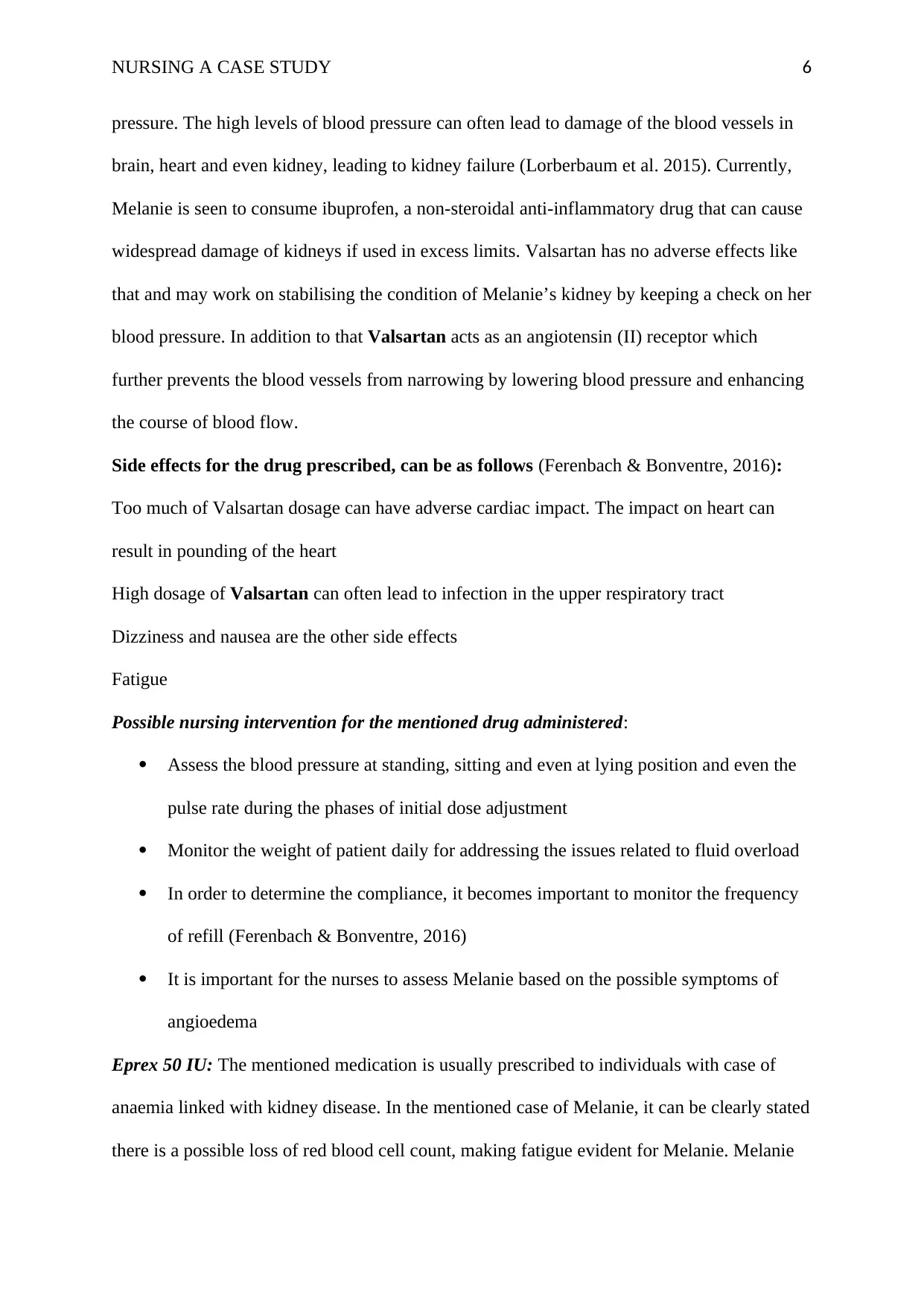
NURSING A CASE STUDY 6
pressure. The high levels of blood pressure can often lead to damage of the blood vessels in
brain, heart and even kidney, leading to kidney failure (Lorberbaum et al. 2015). Currently,
Melanie is seen to consume ibuprofen, a non-steroidal anti-inflammatory drug that can cause
widespread damage of kidneys if used in excess limits. Valsartan has no adverse effects like
that and may work on stabilising the condition of Melanie’s kidney by keeping a check on her
blood pressure. In addition to that Valsartan acts as an angiotensin (II) receptor which
further prevents the blood vessels from narrowing by lowering blood pressure and enhancing
the course of blood flow.
Side effects for the drug prescribed, can be as follows (Ferenbach & Bonventre, 2016):
Too much of Valsartan dosage can have adverse cardiac impact. The impact on heart can
result in pounding of the heart
High dosage of Valsartan can often lead to infection in the upper respiratory tract
Dizziness and nausea are the other side effects
Fatigue
Possible nursing intervention for the mentioned drug administered:
Assess the blood pressure at standing, sitting and even at lying position and even the
pulse rate during the phases of initial dose adjustment
Monitor the weight of patient daily for addressing the issues related to fluid overload
In order to determine the compliance, it becomes important to monitor the frequency
of refill (Ferenbach & Bonventre, 2016)
It is important for the nurses to assess Melanie based on the possible symptoms of
angioedema
Eprex 50 IU: The mentioned medication is usually prescribed to individuals with case of
anaemia linked with kidney disease. In the mentioned case of Melanie, it can be clearly stated
there is a possible loss of red blood cell count, making fatigue evident for Melanie. Melanie
pressure. The high levels of blood pressure can often lead to damage of the blood vessels in
brain, heart and even kidney, leading to kidney failure (Lorberbaum et al. 2015). Currently,
Melanie is seen to consume ibuprofen, a non-steroidal anti-inflammatory drug that can cause
widespread damage of kidneys if used in excess limits. Valsartan has no adverse effects like
that and may work on stabilising the condition of Melanie’s kidney by keeping a check on her
blood pressure. In addition to that Valsartan acts as an angiotensin (II) receptor which
further prevents the blood vessels from narrowing by lowering blood pressure and enhancing
the course of blood flow.
Side effects for the drug prescribed, can be as follows (Ferenbach & Bonventre, 2016):
Too much of Valsartan dosage can have adverse cardiac impact. The impact on heart can
result in pounding of the heart
High dosage of Valsartan can often lead to infection in the upper respiratory tract
Dizziness and nausea are the other side effects
Fatigue
Possible nursing intervention for the mentioned drug administered:
Assess the blood pressure at standing, sitting and even at lying position and even the
pulse rate during the phases of initial dose adjustment
Monitor the weight of patient daily for addressing the issues related to fluid overload
In order to determine the compliance, it becomes important to monitor the frequency
of refill (Ferenbach & Bonventre, 2016)
It is important for the nurses to assess Melanie based on the possible symptoms of
angioedema
Eprex 50 IU: The mentioned medication is usually prescribed to individuals with case of
anaemia linked with kidney disease. In the mentioned case of Melanie, it can be clearly stated
there is a possible loss of red blood cell count, making fatigue evident for Melanie. Melanie
⊘ This is a preview!⊘
Do you want full access?
Subscribe today to unlock all pages.

Trusted by 1+ million students worldwide

NURSING A CASE STUDY 7
may be subjected to prolonged fatigue to the medication and low level of blood volume. The
mentioned medication can thus work on providing a substitute for erythropoietin as the
kidney fails to carry out the mentioned function associated with formation of red blood cells
(Jha et al. 2013)
Side effects for the drug prescribed, can be as follows (Sparke et al. 2013):
Clotting of the possible vascular access sites for people undergoing hemodialysis
To face the possible adverse impact associated symptoms of diarrhea
Swelling of the limbs and even the face
Exhibiting symptoms similar to flu such as joint pain, drowsiness and even fever
Possible nursing intervention for the mentioned drug administered:
The nurse should work on maintaining the levels of fluid consumed
Obtain complete health history of the patient
Maintain a regular dose of iron
Obtain a clear level of potassium and sodium measurement level and keep it in good balance
2.2 Indication of blood test results of Melanie
Based on the blood test it can be stated that Melanie is suffering from low levels of
haemoglobin, suggesting the presence of anaemia. The low levels of GFR in Melanie’s report
suggests that she is suffering from acute case of kidney failure. In addition to that, it can be
seen that Melanie is suffering from poor levels of sodium potassium levels. The poor level of
balance within the mentioned elements can impair the memory. In addition to that fluctuation
in sodium levels can lead to often lead to confusion and even fatigue (Kir et al. 2013). The
low level of potassium within the serum level can lead to problems such as muscle cramps
and even fatigue.
Part 3
3. Melanie asks for advice in managing her chronic renal failure.
may be subjected to prolonged fatigue to the medication and low level of blood volume. The
mentioned medication can thus work on providing a substitute for erythropoietin as the
kidney fails to carry out the mentioned function associated with formation of red blood cells
(Jha et al. 2013)
Side effects for the drug prescribed, can be as follows (Sparke et al. 2013):
Clotting of the possible vascular access sites for people undergoing hemodialysis
To face the possible adverse impact associated symptoms of diarrhea
Swelling of the limbs and even the face
Exhibiting symptoms similar to flu such as joint pain, drowsiness and even fever
Possible nursing intervention for the mentioned drug administered:
The nurse should work on maintaining the levels of fluid consumed
Obtain complete health history of the patient
Maintain a regular dose of iron
Obtain a clear level of potassium and sodium measurement level and keep it in good balance
2.2 Indication of blood test results of Melanie
Based on the blood test it can be stated that Melanie is suffering from low levels of
haemoglobin, suggesting the presence of anaemia. The low levels of GFR in Melanie’s report
suggests that she is suffering from acute case of kidney failure. In addition to that, it can be
seen that Melanie is suffering from poor levels of sodium potassium levels. The poor level of
balance within the mentioned elements can impair the memory. In addition to that fluctuation
in sodium levels can lead to often lead to confusion and even fatigue (Kir et al. 2013). The
low level of potassium within the serum level can lead to problems such as muscle cramps
and even fatigue.
Part 3
3. Melanie asks for advice in managing her chronic renal failure.
Paraphrase This Document
Need a fresh take? Get an instant paraphrase of this document with our AI Paraphraser
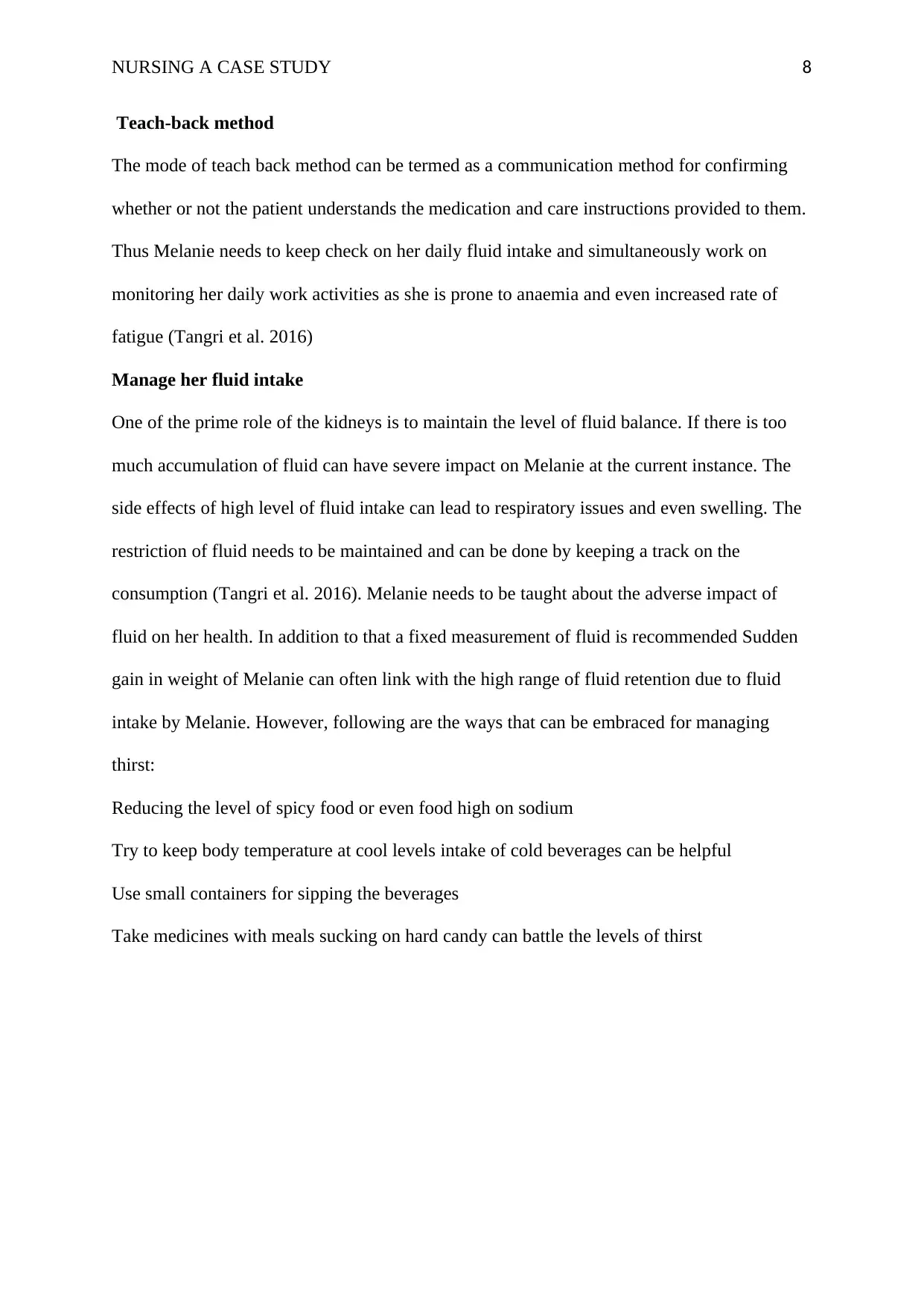
NURSING A CASE STUDY 8
Teach-back method
The mode of teach back method can be termed as a communication method for confirming
whether or not the patient understands the medication and care instructions provided to them.
Thus Melanie needs to keep check on her daily fluid intake and simultaneously work on
monitoring her daily work activities as she is prone to anaemia and even increased rate of
fatigue (Tangri et al. 2016)
Manage her fluid intake
One of the prime role of the kidneys is to maintain the level of fluid balance. If there is too
much accumulation of fluid can have severe impact on Melanie at the current instance. The
side effects of high level of fluid intake can lead to respiratory issues and even swelling. The
restriction of fluid needs to be maintained and can be done by keeping a track on the
consumption (Tangri et al. 2016). Melanie needs to be taught about the adverse impact of
fluid on her health. In addition to that a fixed measurement of fluid is recommended Sudden
gain in weight of Melanie can often link with the high range of fluid retention due to fluid
intake by Melanie. However, following are the ways that can be embraced for managing
thirst:
Reducing the level of spicy food or even food high on sodium
Try to keep body temperature at cool levels intake of cold beverages can be helpful
Use small containers for sipping the beverages
Take medicines with meals sucking on hard candy can battle the levels of thirst
Teach-back method
The mode of teach back method can be termed as a communication method for confirming
whether or not the patient understands the medication and care instructions provided to them.
Thus Melanie needs to keep check on her daily fluid intake and simultaneously work on
monitoring her daily work activities as she is prone to anaemia and even increased rate of
fatigue (Tangri et al. 2016)
Manage her fluid intake
One of the prime role of the kidneys is to maintain the level of fluid balance. If there is too
much accumulation of fluid can have severe impact on Melanie at the current instance. The
side effects of high level of fluid intake can lead to respiratory issues and even swelling. The
restriction of fluid needs to be maintained and can be done by keeping a track on the
consumption (Tangri et al. 2016). Melanie needs to be taught about the adverse impact of
fluid on her health. In addition to that a fixed measurement of fluid is recommended Sudden
gain in weight of Melanie can often link with the high range of fluid retention due to fluid
intake by Melanie. However, following are the ways that can be embraced for managing
thirst:
Reducing the level of spicy food or even food high on sodium
Try to keep body temperature at cool levels intake of cold beverages can be helpful
Use small containers for sipping the beverages
Take medicines with meals sucking on hard candy can battle the levels of thirst
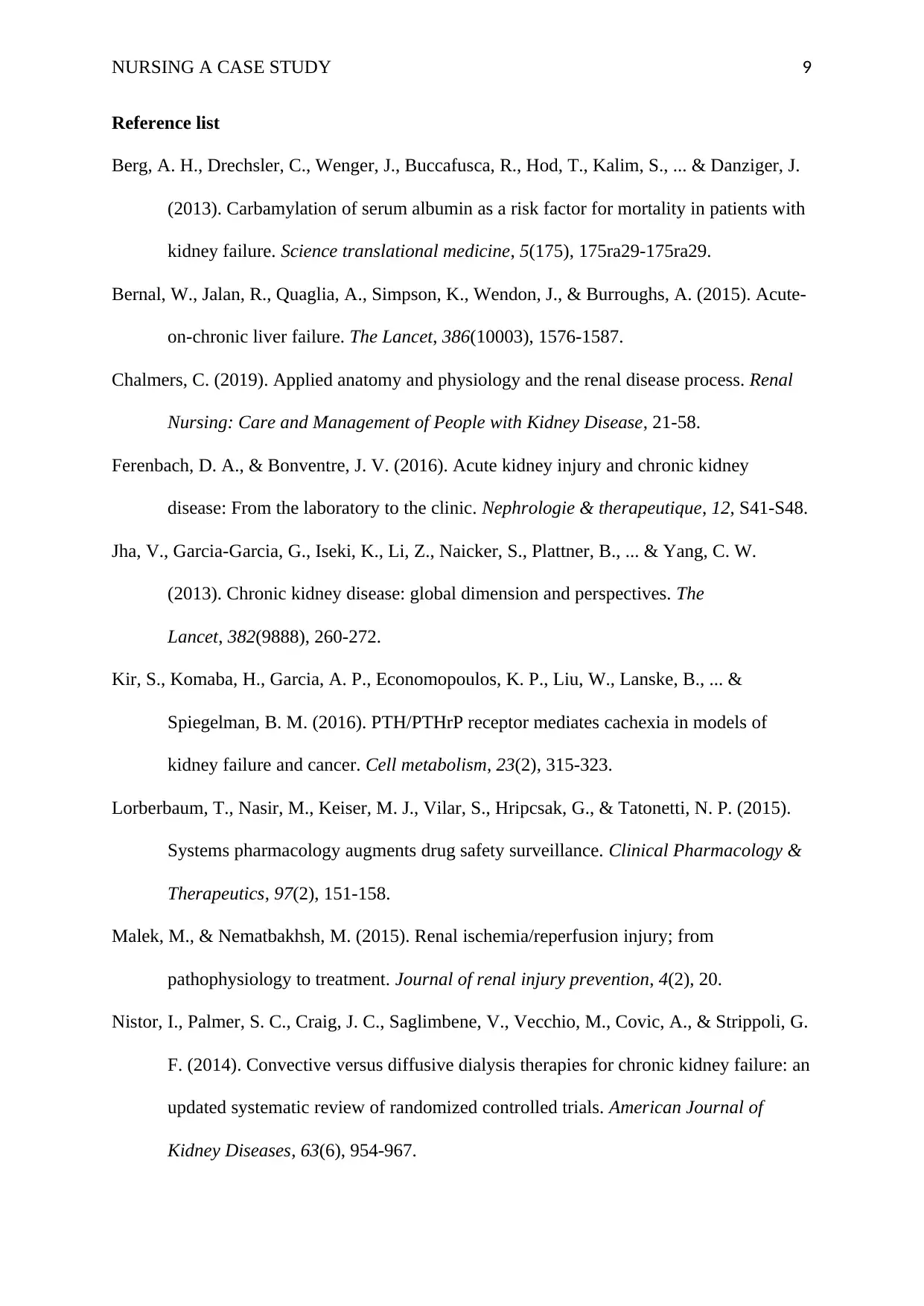
NURSING A CASE STUDY 9
Reference list
Berg, A. H., Drechsler, C., Wenger, J., Buccafusca, R., Hod, T., Kalim, S., ... & Danziger, J.
(2013). Carbamylation of serum albumin as a risk factor for mortality in patients with
kidney failure. Science translational medicine, 5(175), 175ra29-175ra29.
Bernal, W., Jalan, R., Quaglia, A., Simpson, K., Wendon, J., & Burroughs, A. (2015). Acute-
on-chronic liver failure. The Lancet, 386(10003), 1576-1587.
Chalmers, C. (2019). Applied anatomy and physiology and the renal disease process. Renal
Nursing: Care and Management of People with Kidney Disease, 21-58.
Ferenbach, D. A., & Bonventre, J. V. (2016). Acute kidney injury and chronic kidney
disease: From the laboratory to the clinic. Nephrologie & therapeutique, 12, S41-S48.
Jha, V., Garcia-Garcia, G., Iseki, K., Li, Z., Naicker, S., Plattner, B., ... & Yang, C. W.
(2013). Chronic kidney disease: global dimension and perspectives. The
Lancet, 382(9888), 260-272.
Kir, S., Komaba, H., Garcia, A. P., Economopoulos, K. P., Liu, W., Lanske, B., ... &
Spiegelman, B. M. (2016). PTH/PTHrP receptor mediates cachexia in models of
kidney failure and cancer. Cell metabolism, 23(2), 315-323.
Lorberbaum, T., Nasir, M., Keiser, M. J., Vilar, S., Hripcsak, G., & Tatonetti, N. P. (2015).
Systems pharmacology augments drug safety surveillance. Clinical Pharmacology &
Therapeutics, 97(2), 151-158.
Malek, M., & Nematbakhsh, M. (2015). Renal ischemia/reperfusion injury; from
pathophysiology to treatment. Journal of renal injury prevention, 4(2), 20.
Nistor, I., Palmer, S. C., Craig, J. C., Saglimbene, V., Vecchio, M., Covic, A., & Strippoli, G.
F. (2014). Convective versus diffusive dialysis therapies for chronic kidney failure: an
updated systematic review of randomized controlled trials. American Journal of
Kidney Diseases, 63(6), 954-967.
Reference list
Berg, A. H., Drechsler, C., Wenger, J., Buccafusca, R., Hod, T., Kalim, S., ... & Danziger, J.
(2013). Carbamylation of serum albumin as a risk factor for mortality in patients with
kidney failure. Science translational medicine, 5(175), 175ra29-175ra29.
Bernal, W., Jalan, R., Quaglia, A., Simpson, K., Wendon, J., & Burroughs, A. (2015). Acute-
on-chronic liver failure. The Lancet, 386(10003), 1576-1587.
Chalmers, C. (2019). Applied anatomy and physiology and the renal disease process. Renal
Nursing: Care and Management of People with Kidney Disease, 21-58.
Ferenbach, D. A., & Bonventre, J. V. (2016). Acute kidney injury and chronic kidney
disease: From the laboratory to the clinic. Nephrologie & therapeutique, 12, S41-S48.
Jha, V., Garcia-Garcia, G., Iseki, K., Li, Z., Naicker, S., Plattner, B., ... & Yang, C. W.
(2013). Chronic kidney disease: global dimension and perspectives. The
Lancet, 382(9888), 260-272.
Kir, S., Komaba, H., Garcia, A. P., Economopoulos, K. P., Liu, W., Lanske, B., ... &
Spiegelman, B. M. (2016). PTH/PTHrP receptor mediates cachexia in models of
kidney failure and cancer. Cell metabolism, 23(2), 315-323.
Lorberbaum, T., Nasir, M., Keiser, M. J., Vilar, S., Hripcsak, G., & Tatonetti, N. P. (2015).
Systems pharmacology augments drug safety surveillance. Clinical Pharmacology &
Therapeutics, 97(2), 151-158.
Malek, M., & Nematbakhsh, M. (2015). Renal ischemia/reperfusion injury; from
pathophysiology to treatment. Journal of renal injury prevention, 4(2), 20.
Nistor, I., Palmer, S. C., Craig, J. C., Saglimbene, V., Vecchio, M., Covic, A., & Strippoli, G.
F. (2014). Convective versus diffusive dialysis therapies for chronic kidney failure: an
updated systematic review of randomized controlled trials. American Journal of
Kidney Diseases, 63(6), 954-967.
⊘ This is a preview!⊘
Do you want full access?
Subscribe today to unlock all pages.

Trusted by 1+ million students worldwide

NURSING A CASE STUDY 10
Ortiz, A., Covic, A., Fliser, D., Fouque, D., Goldsmith, D., Kanbay, M., ... & Wiecek, A.
(2014). Epidemiology, contributors to, and clinical trials of mortality risk in chronic
kidney failure. The lancet, 383(9931), 1831-1843.
Sparke, C., Moon, L., Green, F., Mathew, T., Cass, A., Chadban, S., ... & McDonald, S.
(2013). Estimating the total incidence of kidney failure in Australia including
individuals who are not treated by dialysis or transplantation. American journal of
kidney diseases, 61(3), 413-419.
Tangri, N., Grams, M. E., Levey, A. S., Coresh, J., Appel, L. J., Astor, B. C., ... & Evans, M.
(2016). Multinational assessment of accuracy of equations for predicting risk of
kidney failure: a meta-analysis. Jama, 315(2), 164-174.
Ortiz, A., Covic, A., Fliser, D., Fouque, D., Goldsmith, D., Kanbay, M., ... & Wiecek, A.
(2014). Epidemiology, contributors to, and clinical trials of mortality risk in chronic
kidney failure. The lancet, 383(9931), 1831-1843.
Sparke, C., Moon, L., Green, F., Mathew, T., Cass, A., Chadban, S., ... & McDonald, S.
(2013). Estimating the total incidence of kidney failure in Australia including
individuals who are not treated by dialysis or transplantation. American journal of
kidney diseases, 61(3), 413-419.
Tangri, N., Grams, M. E., Levey, A. S., Coresh, J., Appel, L. J., Astor, B. C., ... & Evans, M.
(2016). Multinational assessment of accuracy of equations for predicting risk of
kidney failure: a meta-analysis. Jama, 315(2), 164-174.
1 out of 10
Related Documents
Your All-in-One AI-Powered Toolkit for Academic Success.
+13062052269
info@desklib.com
Available 24*7 on WhatsApp / Email
![[object Object]](/_next/static/media/star-bottom.7253800d.svg)
Unlock your academic potential
Copyright © 2020–2025 A2Z Services. All Rights Reserved. Developed and managed by ZUCOL.





